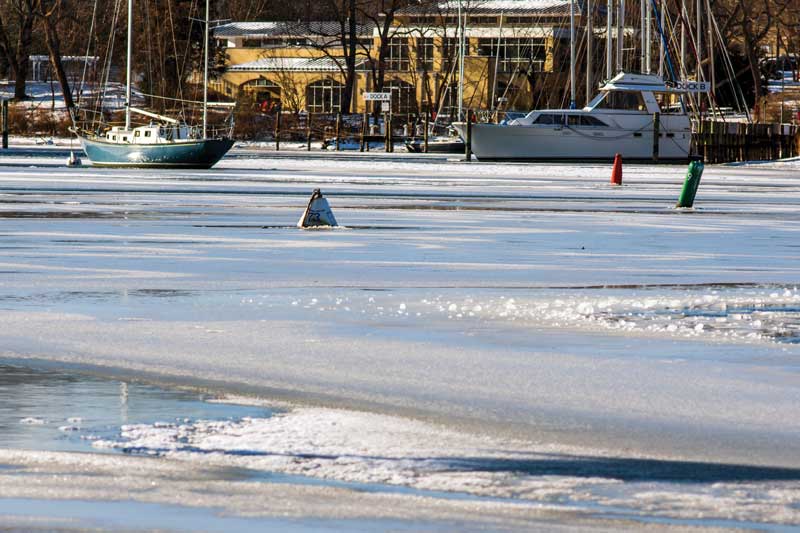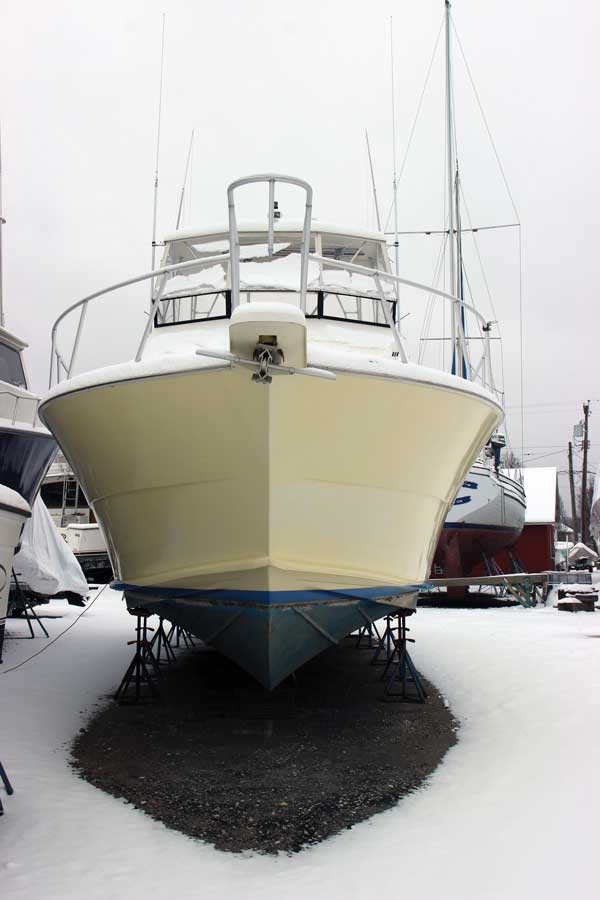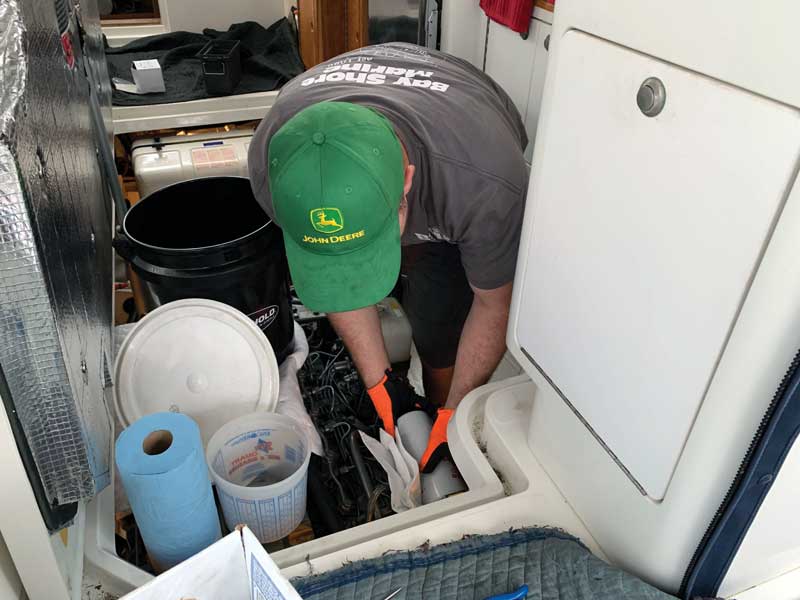“April is the cruelest month,” writes T.S. Eliot in the opening lines to his poem “The Waste Land.” With the exception of New York Nicks fans, no one knows the cruelty of April quite like those boaters who’ve eagerly returned to the marina come spring, only to discover a crack in their engine block. So, while this line may speak to the human condition or something like that, it’s clear to me that Eliot’s real intent was to address the importance of proper winterization.

That interpretation might not go down well in landlubbing literary circles, but the main point still stands: if you winterize your boat now, it’ll hit the Bay running next season. That being said, you don’t want to wait until there’s an enormous hole in your Bimini top to find out you’ve made a mistake.
Winter Woes
As you’re probably aware, most of the damage that boats accumulate over the winter months is due to the formation of ice. When freshwater freezes, its volume expands by about nine percent. That might not sound like a lot, but the force exerted as the water expands can exceed 100,000 psi—which is about twice the amount needed to blow up the barrel of a shotgun Elmer Fudd style. To protect your boat from having an acme-catastrophe of its own, it’s important to figure out where the water is, then remove what you can, treat what you can’t with antifreeze, and stop more from getting in. Keeping that in mind, the first potential problem area to address is also the biggest.

To Pull or Not To Pull
When should I pull the boat? For most boaters, that question creeps up at the point when the back-to-school commercials are replaced with ads for Halloween party stores. Even when the two-month-long Christmas music marathon begins, some will still be holding out for that elusive “last warm day.”
There are a few advantages to leaving your boat in the water over the winter—namely convenience. However, the risks might just outweigh the rewards. For older boats especially, giving the hull time to dry out helps prevent blistering. Plus, having it on dry land allows you to look for any damage and make repairs. But the biggest risk factor is that, over the winter, boats tend to get less supervision.
If you do plan on leaving your boat in its slip, you’ll want to make sure someone’s checking on it regularly. It’s the age-old question: if a bilge pump fails or a dockline snaps, but no one is there to see it, does the boat really sink? Maybe not, but when they come back to an empty slip, most boaters put two and two together rather quickly.
Aside from regular supervision, you can help prevent catastrophe by inspecting docklines and installing chafe guards. The colder months bring wilder tides and inclement weather, so it’s important to tie your lines accordingly. Use long lines at shallow angles to keep the boat centered and check historical tide data to account for the larger shifts in water level. Also, make sure bilge pumps are in good working order and that your battery is attached to some sort of marine trickle charger. That being said, your boat is always going to be better off on terra firma.

Not Quite Ashore Thing
If you do decide to store your boat on land, the next question becomes where to do so. Heated indoor storage is ideal but not always practical. Keep in mind that if your boat is parked on a street, it’ll be an easy target for boat thieves and absent-minded snowplow drivers. It’s also a good idea to avoid overhanging branches as they can fall under the weight of snow or freezing rain. Sloped roofs should also be avoided as falling snow and ice can cause considerable damage. Gated storage areas are always going to be the safest bet for outdoor storage. However, keeping your vessel close to home provides peace of mind.
In terms of what you store your boat on, there are plenty of methods to choose from: trailers, jack stands, cradles, dry storage racks… Trailers are a great option because they’re adjustable and make it easier to transport your boat in the spring. A custom-built wood or steel cradle can offer superior support and prevent anyone from driving off with your boat. Jack stands can also work, but their convenience comes with a few drawbacks. Always make sure they’re placed on solid ground and consult the boat’s manufacturer for a blocking plan.
When it comes to keeping water out, your best bet is going to be a well-fitted canvas or synthetic cover. Shrinkwrapping is also a good option, but it’s best to leave it to the professionals. In either case, ventilation is key. Even if you chose to have your boat wrapped, water can still build up in the form of condensation.

Water Whereabouts
The first step to dealing with water is to locate it and then drain it, treat it, and keep it out. Freshwater systems should be completely drained, but they also have to be treated with a nontoxic propylene glycol antifreeze because water will pool out throughout the system. Along with that, there’s one winterization mistake that boaters are guaranteed to never make twice—treating the head. If you can, it should be drained, removed, and stored. If the head is fitted with a holding tank, it should be pumped out, filled with disinfectant and antifreeze, and then shut off (just remember to open the seacocks come spring).
The discharge lines of your bilge pumps and other raw water pumps should be drained and/or treated with antifreeze. Fish boxes and lockers should also be thoroughly inspected for residual water. In general, all drainplugs should be removed. If properly covered, this shouldn’t be a problem; however, one-way drainplugs are a good call in areas prone to heavy rain or hurricanes.
Engine Block Blues
Engines come in all shapes and sizes, so it’s important to consult your owner’s manual before trying to winterize it. For the vast majority, you’re going to want to drain out everything from the raw water loop. Freshwater loops don’t have to be drained, but it’s a good idea to check that they are properly treated with anti-freeze. Fuel lines and carburetors should also be drained; and while you’re at it, you might as well replace your oil, oil filters, and fuel filters. Fuel should be treated with a stabilizer and—and if it contains ethanol—BoatU.S. recommends filling the tank to 95 percent to prevent phase separation.
According to outboard-aficionado Lenny Rudow, “The biggest mistake I see folks make time and time again is running antifreeze through an outboard. Outboards are designed to drain out 100 percent of the water in them when in the tilted-down position. If you run antifreeze through one, you’re doing just that—running it through, so it can spill out onto the driveway or parking lot.”
By Ryan Gullang